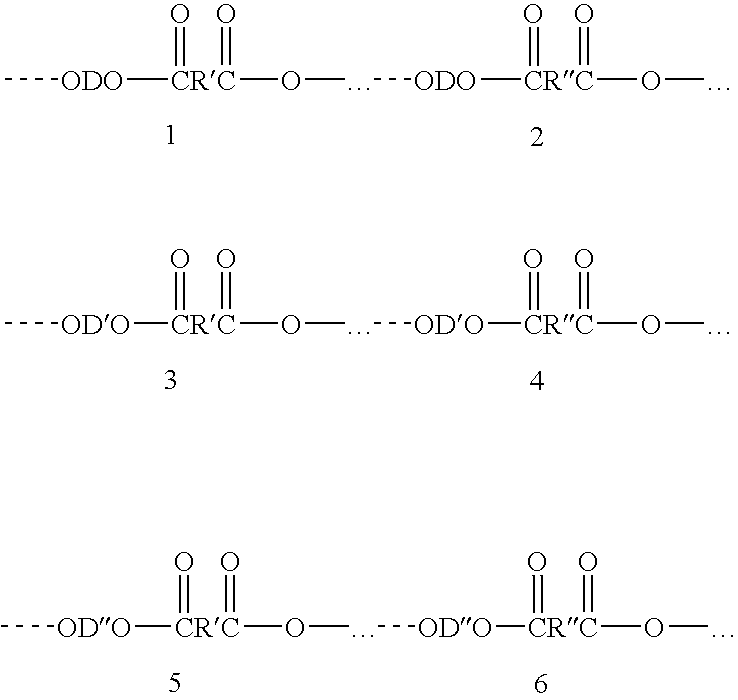Process for making polybutylene terephthalate (PBT) from polyethylene terephthalate (PET)
a technology of polybutylene terephthalate and polyethylene terephthalate, which is applied in the direction of dyeing process, plastic recycling, textiles and papermaking, etc., can solve the problems of not meeting the long-held need of improving use, disposed of in landfills, and pbt-filler molding compositions generally cannot be made from pbt-recycle sources
- Summary
- Abstract
- Description
- Claims
- Application Information
AI Technical Summary
Benefits of technology
Problems solved by technology
Method used
Image
Examples
examples 1-9
[0090]The overall quantity of individual materials taken and the reaction scale used are indicated in Table 1.
TABLE 1Amounts of raw materials taken and reaction scale for Examples 1–91Scale ofOverall ratio ofreactionprincipal rawPBTmaterialsDepolymerization stageTransesterification stageamountBDO:PETEGPETBDOpreparedEG:PETmoletakentakenCatalysttakenCatalyst,CocatalystExample no.(g)mole ratioratio(g)(g)(ppm)(g)Ti (ppm)(ppm)180001.273.628007000No11800(100)—addedcatalyst280001.273.628007000Sb11800(50 + 50)*—(100)380001.53.634007000Ti (50)11800(50 + 50)*—480001.52.434007000Ti (50)8000(50 + 50)*—5234.21.53.695.9204.1Ti (50)344.4(100)—6234.21.53.695.9204.1Ti (50)344.9(100)—7234.21.53.695.9204.1Ti (50)344.4(100)—8234.21.53.695.9204.1Ti (50)344.3(100)NaOMe(13.8)9234.21.53.695.9204.1Ti (50)344.1(100)NaOMe(13.8)1No additional ingredient was added at the polymerization stage.*The catalyst is added in two parts - first part at atm. pressure and the second part at 80 kPa
[0091]Green colored PET sc...
example 10
Solid State Polymerization:
[0100]In order to get a high value of intrinsic viscosity (IV) for the PET derived PBT, a low viscosity sample from example 4 (IV=0.79) was subjected to solid state polymerization in a tumbling reactor at 100 mbar pressure at a temperature of 190-220 deg C. for about 48 to 72 h. The intrinsic viscosity was checked intermittently during the viscosity build-up and a product with a final intrinsic viscosity value of 1. 19 was obtained. This example 10 is illustrative of a process for obtaining polymer samples of PET derived PBT of high intrinsic viscosity.
example 11
Synthesis of Butanediol from Corn Based Succinic Acid
[0101]The purpose of this example is to show that BDO can be derived from biomass.
Techniques / Procedures
[0102]Bio-succinic acid for the experiments performed in example 19 was sourced from Diversified Natural Products.BDO from bio Succinic acid was synthesized in a two-step process as below:
Step (1): Esterification of Succinic Acid to Diethyl Ester:
[0103]In a 2.0 litre RB flask on an oil bath with overhead stirrer and condenser arrangement, 200 grams (1.69m) of bio Succinic acid, 1.0 litre of dry Ethyl alcohol and 5-8drops of concentrated H2SO4 were charged and heated to reflux for 8 hrs. After 8 hrs the alcohol was distilled off, 500 ml dichloromethane was added, and washed with 450 ml of 10% sodium carbonate solution to get distinctly alkaline pH. The organic layer was washed with water and then dried over anhydrous sodium sulfate. The solvent was removed and the diester product was distilled off under vacuum. The pure diester wa...
PUM
| Property | Measurement | Unit |
|---|---|---|
| Temperature | aaaaa | aaaaa |
| Temperature | aaaaa | aaaaa |
| Temperature | aaaaa | aaaaa |
Abstract
Description
Claims
Application Information
 Login to View More
Login to View More - R&D
- Intellectual Property
- Life Sciences
- Materials
- Tech Scout
- Unparalleled Data Quality
- Higher Quality Content
- 60% Fewer Hallucinations
Browse by: Latest US Patents, China's latest patents, Technical Efficacy Thesaurus, Application Domain, Technology Topic, Popular Technical Reports.
© 2025 PatSnap. All rights reserved.Legal|Privacy policy|Modern Slavery Act Transparency Statement|Sitemap|About US| Contact US: help@patsnap.com



